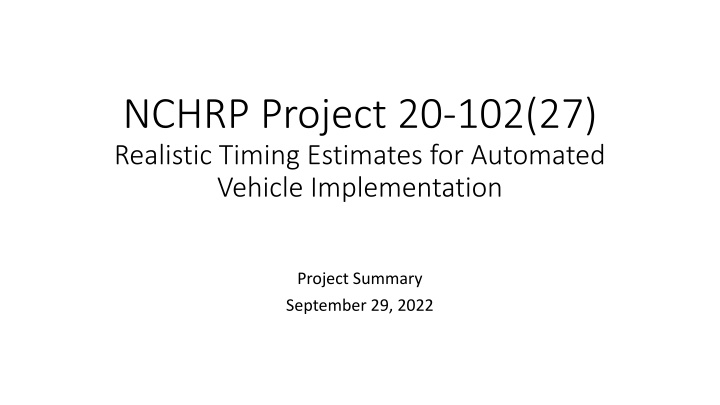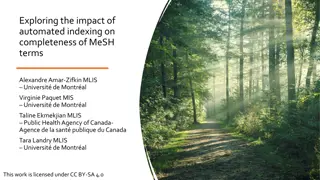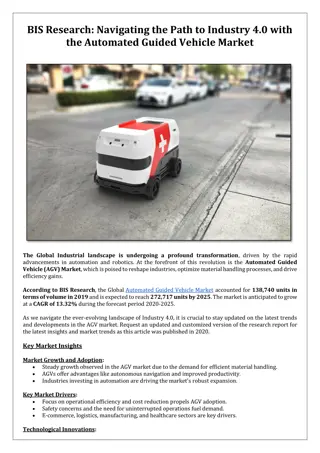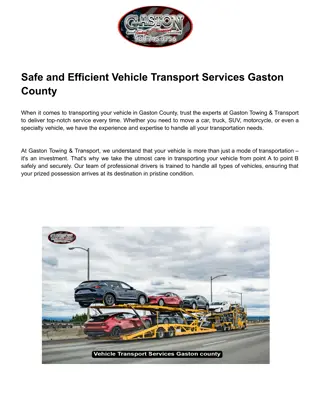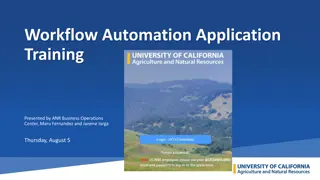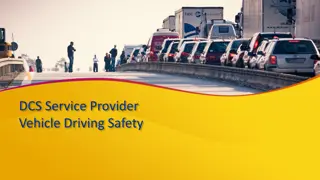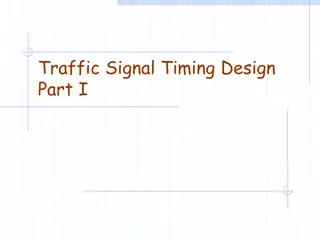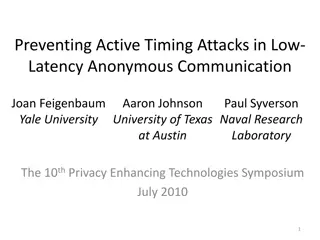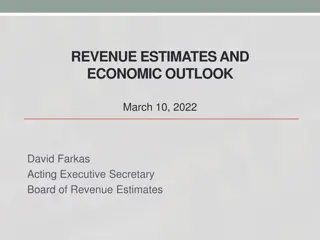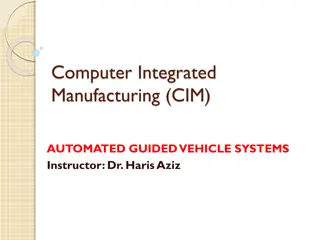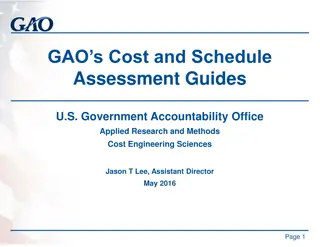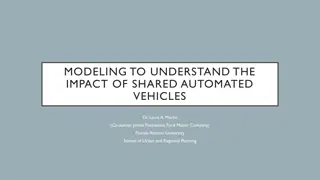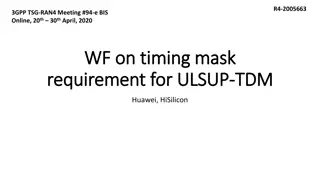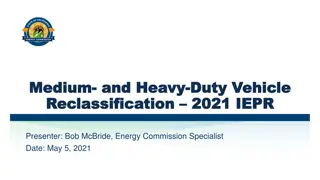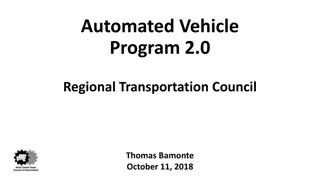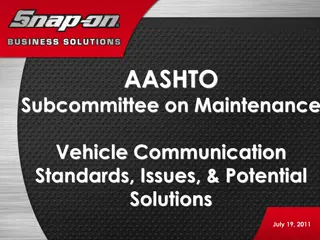Realistic Timing Estimates for Automated Vehicle Implementation
The project focuses on identifying factors affecting the deployment timing of Society of Automotive Engineers Level 4 AV technologies, understanding market forecasts, developing deployment estimations, and updating recommendations for decision-making models. It aims to assist state DOTs and infrastructure operators in preparing for the future of connected and autonomous vehicles, addressing questions related to infrastructure updates, market share assumptions, transition strategies, cybersecurity standards, and equity in mobility options.
Uploaded on Mar 12, 2025 | 2 Views
Download Presentation

Please find below an Image/Link to download the presentation.
The content on the website is provided AS IS for your information and personal use only. It may not be sold, licensed, or shared on other websites without obtaining consent from the author.If you encounter any issues during the download, it is possible that the publisher has removed the file from their server.
You are allowed to download the files provided on this website for personal or commercial use, subject to the condition that they are used lawfully. All files are the property of their respective owners.
The content on the website is provided AS IS for your information and personal use only. It may not be sold, licensed, or shared on other websites without obtaining consent from the author.
E N D
Presentation Transcript
NCHRP Project 20-102(27) Realistic Timing Estimates for Automated Vehicle Implementation Project Summary September 29, 2022
The National Cooperative Highway Research Program (NCHRP) is sponsored by the individual state departments of transportation of the American Association of State Highway and Transportation Officials. NCHRP is administered by the Transportation Research Board (TRB), part of the National Academies of Sciences, Engineering, and Medicine, under a cooperative agreement with the Federal Highway Administration (FHWA). Any opinions and conclusions expressed or implied in resulting research products are those of the individuals and organizations who performed the research and are not necessarily those of TRB; the National Academies of Sciences, Engineering, and Medicine; the FHWA; or NCHRP sponsors.
Contents Background and Objectives Research Approach Findings and Conclusions
Background Infrastructure Owners/Operators have a lot of questions about an AV future What is my ability to influence what combination of levers to create desired outcomes? For example, will we be required to create permits or other regulatory documents/processes to allow these vehicles on our roads, and at what point would it be in our interests to do so? What AV market share should we assume in our 2040 transportation plan? When should infrastructure be updated to account for the various automation types? How will infrastructure needs and adoption rates be affected by function, features and external conditions? How much and for how long should we subsidize AV testing before the market matures? What transition strategy could we adopt to reap benefits of AVs sooner? What cybersecurity and digital data governance standards must we implement? How do we ensure equity of mobility options across communities?
Objectives Identify influencing factors and risks that affect the timing of the deployment of the Society of Automotive Engineers (SAE) Level 4 AV technologies, described in SAE J3016, in diverse scenarios Better understand existing market forecasts Define operational concept and input parameters for a decision-making model that will estimate deployment timeframes Develop recommendations for how and at what frequency a model and its parameters should be updated Audience: State DOTs and other IOOs state, county, city, regional planning organizations, transit agencies, toll authorities, etc. and any others in the CAV industry who may be interested
Task 1: Task 1: Influencing Factors Documented 16 examples of previous AV forecasting efforts More common for documents to adopt assumption of AV deployment and focus on secondary effects Goals were to: Understand objective vs. subjective factors Identify influencing factors and risks
Identify Influencing Factors and Risks Factors from previous efforts combined with project team research and brainstorming Identifying factors was a dynamic and judgment-based exercise Extracted bulk list of 39 unique factors (see reference slides) Useful to distinguish pre-market (current) and market (future) forecasting methods At this time, we can only use intuition and interviews to guess when a market will develop. Once it does, we can activate a formal forecasting model.
Task 2: Task 2: Development of Three Framework Components Identifying the Key Actors (Stakeholders) Breaking the Problem into Relevant Pieces (Use Case Scenarios) Understanding the Relevant Information (Input Parameters) Freight Vehicles Current Technological Capabilities Vehicle Producers/Providers Transit Vehicles Government Regulations Infrastructure Owners/Operators Fleet Vehicles (ride-hailing robotaxis) Average Travel Behavior and Comparable Benefits by AV and Non-AV Transit/Transportation Agencies Personal Passenger Vehicles Financial Institutions/Investors General Consumer Trends Public Officials/Politicians Technology Costs Consulting/Strategy Firms Investor Sentiment and Forecasts Research Companies, Academics, & Think Tanks
Task 3: Task 3: Summarizing Project Findings Final Report Presentation Materials
Pre-market vs. Market Forecasting Separate forecasting methods must be applied to each stage of technology maturity: 1. Pre-market framework: forecast the time to and dynamics of the establishment of a meaningful consumer market, necessarily relying on subjective input such as expert interviews and heuristics 2. Market framework: significant revenue is derived from consumer-ready technology, utilizing data-based correlations to the extent possible At this time, we are limited to performing pre-market forecasting, but can prepare a framework for a data-based model once we have more evidence of adoption in market.
Desired Framework Outputs Certainty of outputs needs to be reported clearly IOOs need to know when to consider making investments in anticipation of impeding widespread adoption of AVs Trigger points, such as specified AV market shares, should be used to indicate when IOOs should reevaluate their policies and plans This is a framework for a premarket model that will need to be reviewed and adjusted once the market is more mature perhaps in a series of increments
Use Cases Freight Both long haul and short haul Transit Both low-speed AV shuttles and full-size buses Fleet Vehicles Privately operated fleets used for passenger travel Including ridesharing, ride hailing, carsharing, etc. provided to consumers through a private fleet operator Personal Vehicles AVs deployed as privately owned vehicles
Use Cases Freight Key Characteristics: Pre-planned operations along a route or within a zone (with no deviations caused by dynamic passenger demands) Platooning Clear business case and partnership potential
Use Cases Transit Key Characteristics: Fixed route service on a dedicated right of way (initially) Potential for cost savings and network expansion due to vehicle right-sizing
Use Cases Fleet Vehicles Key Characteristics: On-demand operations within a pre-mapped zone Enabled by a reduction in labor cost
Use Cases Personal Vehicles Key Characteristics: Replacement of existing primary travel model with the same model, only the driving task is delegated to the AV Main difference from current predominant model is the delegation of the driving task, and how that enables independent access for new user groups (older adults, people with disabilities, children, etc.)
Priority Input Parameters Current technological capabilities Government regulations and policies Investments in other related factors (roads, traffic control, etc.) Average travel behavior and comparable benefits by AV and by non-AV General consumer trends Technology costs Development cost and cost to users (insurance, tax incentives, e-commerce and remote work trends) Investor sentiment and forecasts
Key Actors and Decision Makers Key Actors Vehicle producers/providers and AV developers Private transportation operators Decision Makers Infrastructure owners/operators (includes transit and other public agencies) Financial institutions/investors Public officials/politicians Observers/Analysts Consulting/strategy firms Research companies, academic researchers, think tanks Consumers/general public/media coverage
Model Framework and Outputs Types of questions to be answered Model framework structure and operational concept Premarket forecast Assumptions and interdependencies Key risks Outputs Recommended next steps
Types of Questions What is my ability to influence what combination of levers to create desired outcomes? For example, will we be required to create permits or other regulatory documents/processes to allow these vehicles on our roads, and at what point would it be in our interests to do so? What AV market share should we assume in our 2040 transportation plan? When should infrastructure be updated to account for the various automation types? How will infrastructure needs and adoption rates be affected by function, features and external conditions? How much and for how long should we subsidize AV testing before the market matures? What transition strategy could we adopt to reap benefits of AVs sooner? What cybersecurity and digital data governance standards must we implement? How do we ensure equity of mobility options across communities?
Assumptions and Interdependencies Rates of change for past technologies will be similar for AVs Measures of success will be consistent Continued monitoring and updates will be possible Dynamics and relationships between input parameters will remain the same (not magnitude, but direction) Other forecasting efforts that will be informed will remain consistent J3016 definitions of Level 4 AVs will remain consistent and widely adopted
Key Risks: Building Uncertainty Into The Model Framework What if the trajectory of a trend deviates from what we already know and what we expect? Where will this new trend make the biggest impact? What major changes will result? Who will benefit from or be impacted by such changes?
Key Risks and Uncertainties Cybersecurity and data privacy Connectivity Electrification Infrastructure readiness Upfront capital costs Operating system maintenance costs Federal and state regulations Insurance and liability Interactions with other road users Remaining technology challenges and limitations
Outputs Reasonable considerations for near term and long-range planning and infrastructure requirements AVs will be designed to operate on the roads available IOOs must decide whether and when it is worthwhile to make changes that could improve the safety or implementation speed of AVs Optimistic to conservative scenario outputs based on optimistic to conservative assumptions of input parameter values Projecting past trends into the future A framework for decision making that stakeholders can use regardless of their current environment or needs
Model Framework Triggers Other related technologies such as connected vehicles, electric vehicles, mobility as a service platforms, etc. are widely adopted Level 4 AVs have a x% market share of new vehicle purchases Actual Level 4 deployments occur in other countries (even if the vehicles are not yet permitted to operate in the United States) Federal government regulation passes (so some assumed scenarios can be removed) Other conditions change significantly (i.e., a pandemic significantly alters commuting behavior, perhaps permanently)
Recommended Next Steps This project has presented a framework for model development The next step should be to develop the actual model and run it using the range of input parameters proposed Model should be updated when certain trigger points are reached Post-market model can be created before its trigger point is reached, and then implemented at that point once fewer uncertainties remain
A Call to Action This research has identified several weaknesses in the current approach to forecasting the future of the AV marketplace This framework sets the stage for incorporating additional metrics and influencing factors as they become available As a community, we need to spend a lot more energy in narrowing down these metrics and monitoring them for opportunities to garner objective data. As we do that, an opportunity to enhance current models (or build new ones) will obviously be enhanced.
Summary The framework is for a pre-market forecasting tool and will need to be updated once AVs are a significant portion of the market The framework includes triggers, or specific events that are considered significant towards level 4 AV deployment The purpose of the framework is for IOOs to better understand what to look out for in the future, including what progress is notable and could directly impact IOO operations, rather than to provide a specific expected date for level 4 AV deployment
Identify Influencing Factors Analog to previous technology adoption patterns AV consumer sales AV PMT and VMT Average time spent in vehicles AVs in commercial service AVs in public testing Battery and battery replacement costs Cleaning costs Comparative benefits to level 2 ADAS Complexity of ODD Congestion Consumer sentiment Cost relative to traditional vehicle Cost to consumer Depreciation Developer announcements Financing costs Fuel/charging costs Geofence ODD Initial deployment date Insurance cost Investment/Venture Capital Investor sentiment Lifecycle costs Machine learning time Maintenance costs Manufacturing costs Modal split Operating costs Parking availability and costs Range (EV) Regulations (government enablement or prohibitions) Repair costs Reported disengagements per mile Service life Transit availability/use Vehicle scrap rate Vehicle utilization rate
Use Cases Freight Challenges/Limitations: Distribution between larger and smaller vehicles and security may continue to require a human presence High vehicle technology costs may limit initial business case viability Priority Input Parameters Key Actors Vehicle producers Private transportation operators Public officials IOOs Vehicle producers Investors Consumers Current technological capabilities Government regulations Technology costs Investor sentiment and forecasts
Use Cases Transit Challenges/Limitations: Passenger assistance may continue to necessitate a human presence, so it may be difficult to justify the increased technology costs with limit cost savings Priority Input Parameters Key Actors Vehicle producers Current technological capabilities Government regulations Public officials IOOs General consumer trends Consumers Technology costs Vehicle producers Investors
Use Cases Fleet Vehicles Priority Input Parameters Key Actors Vehicle producers Private transportation operators Public officials IOOs Consumers IOOs Researchers Investors Consulting/strategy firms Vehicle producers Consumers Challenges/Limitations: Requires consumer demand/ societal behavior change Need for assurance of data and personal security Sharing of vehicles or sharing of rides? Current technological capabilities Government regulations Average travel behavior and comparable benefits by AV and by non-AV Investor sentiment and forecasts Technology costs General consumer trends
Use Cases Personal Vehicles Priority Input Parameters Key Actors Vehicle producers Challenges/Limitations: Economic viability (higher cost in almost every respect, except potential for lower insurance cost) Higher emphasis on comfort, lower emphasis on performance Congestion impact Current technological capabilities Government regulations Public officials IOOs Average travel behavior and comparable benefits by AV and by non-AV Consumers IOOs Researchers Technology costs Vehicle producers Investor sentiment and forecasts Investors Consulting/strategy firms General consumer trends Consumers
Assumptions for Parameter Values: Current Technological Capabilities Focus on current capabilities, not anticipated improvements Look at level of effort and investment that has been required to achieve these capabilities Historical data on the rate of growth of new features and enhancements Proven safety record are promised benefits actually occurring? Assessment of ODD usability/limitations Urban or rural applications, climate/weather, roadway classifications, interaction with vulnerable road users, topography, geometric design, and infrastructure/asset readiness A geographic limitation may be easier to work around than a weather limitation, for example
Assumptions for Parameter Values: Government Regulations and Policies Separation of federal and state roles Current approaches Anticipated changes (multiple scenarios)
Assumptions for Parameter Values: Average travel behavior and comparable benefits by AV and by non-AV Surveyed receptiveness to driving task delegation Actual adoption of related technologies and actual current travel choices, such as willingness to share rides Value of time and other metrics that quantify the benefits of moving towards AVs Safety, including safety of non-AV users
Assumptions for Parameter Values: General Consumer Trends The amount of time and the conditions needed for different sectors of the user population to adopt new technologies and services Understanding of varying lifestyles, societal norms, and access to technology Amount and type of passenger and goods movement applications in personal and fleet vehicle operation Tolerance to the capabilities of partially automated vehicles Switching between modes when moving between zones or different roadway classifications Climate/weather limitations Infrastructure/asset readiness
Assumptions for Parameter Values: Technology Costs The ability of private entities to safely deploy AV technologies while considering barriers related to costs, technological limitations, supply chain, and local regulatory environments Investor support and other subsidies Cost to consumers Capital and operating considered separately
Assumptions for Parameter Values: Investor Sentiment and Forecasts How much investors are willing to subsidize initial AV operations Insurance industry response Industry forecasts for AV deployment, and changes in industry forecasts over time
Key Actor and Decision Maker Influence Table Average travel behavior and comparable benefits by AV and by non-AV Current technological capabilities General consumer trends Investor sentiment and forecasts Government regulations Technology costs IOOs Secondary Primary Private transportation operators Secondary Vehicle producers Primary Primary Investors Secondary Primary Consulting/strategy firms Secondary Secondary Researchers Secondary Public officials Primary Consumers Primary
